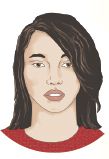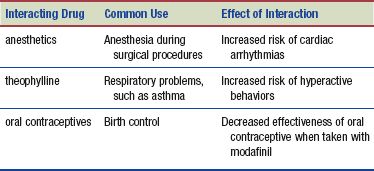DRUG CLASSES
Amphetamines
Analeptics
Anorexiants
This chapter discusses the drugs that stimulate the central nervous system (CNS) and the nursing implications related to their administration. The three basic classes of stimulants are amphetamines, analeptics, and anorexiants. The definitions of these classes are presented in Display 18.1. These drugs are used with caution because the CNS stimulants have a high abuse potential due to their ability to produce euphoria and wakefulness.
CENTRAL NERVOUS SYSTEM STIMULANTS
Actions
The amphetamines are sympathomimetic (i.e., adrenergic) drugs, meaning they stimulate the CNS to speed up (see Chapter 24). Their drug action results in an elevation of blood pressure, wakefulness, and an increase or decrease in pulse rate. Amphetamines also produce a euphoric state; this pleasurable feeling is what increases their dependency potential.
One condition successfully treated by amphetamines is attention deficit hyperactivitydisorder (ADHD) in children. Amphetamines work by blocking the reuptake of norepinephrine and dopamine. This lessens the action of other neurotransmitters, thus helping to focus concentration and attention.
PHARMACOLOGY IN PRACTICE

Janna Wong is a 16-year-old high school gymnast. Mrs. Wong has brought her to the clinic after reading on the Internet about attention deficit hyperactivity disorder (ADHD). She is worried that Janna’s lack of focus on training may be due to this disorder. She is here to have medications prescribed for her daughter.
One of the most widely used CNS stimulants is caffeine. It is a mild to potent analeptic CNS stimulant. Analeptics increase the depth of respirations by stimulating special receptors located in the carotid arteries and upper aorta. These special receptors (called chemoreceptors) are sensitive to the amount of oxygen in arterial blood. Stimulation of these receptors results in an increase in the depth of respirations. Caffeine is an analeptic that stimulates the CNS at all levels, including the cerebral cortex, the medulla, and the spinal cord. Caffeine also has mild diuretic activity. People take caffeine on their own in the form of coffee, tea, or even chocolate, yet caffeine’s use as a therapeutic drug for stimulation in the neonatal setting is growing. Other actions of analeptics include cardiac stimulation (which may produce tachycardia), dilation of coronary and peripheral blood vessels, constriction of cerebral blood vessels, and skeletal muscle stimulation.
Display 18.1 Central Nervous System Stimulants and Definitions
Analeptics. Drugs that stimulate the respiratory center of the brain and cardiovascular system, used with narcolepsy and as an adjuvant treatment for obstructive sleep apnea
Amphetamines. Drugs used to treat children with attention deficit hyperactivity disorder (ADHD)
Anorexiants. Drugs used to suppress the appetite
Modafinil (Provigil) and armodafinil (Nuvigil) are analeptics used to treat narcolepsy (a disorder that causes an uncontrollable desire to sleep during normal waking hours even though the individual has a normal nighttime sleeping pattern). The exact mechanism of action is not known, but the drugs are thought to bind to dopamine, thereby reducing the number of episodes. It does not cause cardiac and other systemic stimulatory effects like other CNS stimulants. These drugs are sometimes used in the treatment of obstructive sleep apnea to promote daytime wakefulness (not to replace continuous positive airway pressure during sleep).
The anorexiants are drugs pharmacologically similar to the amphetamines. Their ability to suppress the appetite is thought to be due to their action on the appetite center in the hypothalamus.
Uses
The CNS stimulants are used in the treatment of the following:
• ADHD
• Drug-induced respiratory depression
• Postanesthesia respiratory depression, without reduction of analgesia
• Narcolepsy
• Obstructive sleep apnea
• Exogenous obesity
• Fatigue (caffeine)
 NURSING ALERT
NURSING ALERT
ADHD is a condition of both children and adults and is characterized by inattention, hyperactivity, and impulsivity. Because these behaviors, when independently present, can be normal in any individual, it is important that the child receive a thorough examination and appropriate diagnosis by a well-qualified professional before drug therapy is initiated (Fig. 18.1).

Figure 18.1 Children should always have a thorough examination before stimulants for attention deficit hyperactivity disorder (ADHD) are prescribed. (From Bickley, L. S., & Szilagyi, P. [2003]. Bates’ guide to physical examination and history taking [8th ed.]. Philadelphia: Lippincott Williams & Wilkins.)
Adverse Reactions
Neuromuscular System Reactions
• Excessive CNS stimulation, headache, dizziness
• Apprehension, disorientation, hyperactivity
Other Reactions
• Nausea, vomiting, cough, dyspnea
• Urinary retention, tachycardia, palpitations
For more information on adverse reactions, see the Summary Drug Table: Central Nervous System Stimulants.
Contraindications
The CNS stimulants are contraindicated in patients with known hypersensitivity or convulsive disorders and in those with ventilation disorders (e.g., chronic obstructive pulmonary disease [COPD]). Do not administer CNS stimulants to patients with cardiac problems, severe hypertension, or hyperthyroidism. CNS stimulants are not recommended as treatment for depression. Amphetamines and anorexiants should not be taken concurrently or within 14 days of antidepressant medications. In addition, amphetamines are contraindicated in patients with glaucoma. Most anorexiants are classified as pregnancy category X and should not be used during pregnancy. Although armodafinil is considered a pregnancy category C drug, its safety has not been proven.
 NURSING ALERT
NURSING ALERT
Stimulants enhance dopamine transmission to areas of the brain that interpret well-being. To maintain pleasurable feelings, people continue the use of stimulants, which leads to their abuse and the potential for addiction.
Precautions
The CNS stimulants should be used cautiously in patients with respiratory illness, renal or hepatic impairment, and history of substance abuse. The CNS stimulants should be used cautiously in pregnant or lactating women.
Interactions
The following drugs may interact with a CNS stimulant when it is administered with them:

NURSING PROCESS
PATIENT TEACHING FOR MEDICATION INFORMATION
ASSESSMENT
Assessment of the patient receiving a CNS stimulant depends on the drug, the patient, and the reason for administration.
Preadministration Assessment
ATTENTION DEFICIT HYPERACTIVITY DISORDER. When an amphetamine is prescribed for any reason, weigh the patient and take the blood pressure, pulse, and respiratory rate before starting drug therapy. Work with the family to describe and document the observed behavior patterns the child with ADHD demonstrates for later comparison. If the child is hospitalized, ask the family for feedback and enter daily observations of the child’s behavior into the patient’s record. This provides a record of the results of therapy.
 LIFESPAN CONSIDERATIONS
LIFESPAN CONSIDERATIONS
Pediatric
An increased risk of suicidal ideation in children and adolescents has been found when using the drug atomoxetine (Strattera). Patients with ADHD started on atomoxetine should be monitored carefully for suicidal thoughts or behaviors. Teach the family about specific behaviors to observe for and build confidence in how to ask their children about suicidal thinking that would indicate a need to contact the primary health care provider.
RESPIRATORY DEPRESSION. When a CNS stimulant is prescribed for respiratory depression, initial patient assessments include the blood pressure, pulse, and respiratory rate. It is important to note the depth of the respirations and any pattern to the respiratory rate, such as shallow respirations or alternating deep and shallow respirations. Review recent laboratory test results (if any), such as arterial blood gas studies. It is important to scan the chart to identify the drugs causing the respiratory depression.
OBESITY. When an anorexiant is used as part of obesity treatment, the drug is usually prescribed for outpatient use. Obtain and document the blood pressure, pulse, respiratory rate, and weight before therapy is started and at each outpatient visit.
Ongoing Assessment
RESPIRATORY DEPRESSION. After administering an analeptic, carefully monitor the patient’s respiratory rate and pattern until the respirations return to normal. You should also monitor the level of consciousness, blood pressure, and pulse rate at 5- to 15-minute intervals or as ordered by the primary health care provider. Arterial blood gases may be drawn for analysis at intervals to determine the effectiveness of the analeptic, as well as the need for additional drug therapy. It is important to observe the patient for adverse drug reactions and to report their occurrence immediately to the primary health care provider.
NURSING DIAGNOSES
Drug-specific nursing diagnoses are the following:
 Disturbed Sleep Pattern related to CNS stimulation and hyperactivity, nervousness, insomnia, other (specify)
Disturbed Sleep Pattern related to CNS stimulation and hyperactivity, nervousness, insomnia, other (specify)
 Ineffective Breathing Pattern related to respiratory depression
Ineffective Breathing Pattern related to respiratory depression
 Imbalanced Nutrition: Less Than Body Requirements related to diminished appetite
Imbalanced Nutrition: Less Than Body Requirements related to diminished appetite
Nursing diagnoses related to drug administration are discussed in Chapter 4.
PLANNING
The expected outcomes for the patient depend on the reason for administration of a CNS stimulant but may include an optimal response to therapy, support of patient needs related to management of adverse drug reactions, and confidence in an understanding of the medication regimen.
IMPLEMENTATION
Promoting an Optimal Response to Therapy
Stimulants are used long term for ADHD and may be used in the short-term treatment of exogenous obesity (obesity caused by a persistent calorie intake that is greater than needed by the body). However, their use in treating exogenous obesity has declined, because the long-term use of the amphetamines for obesity carries the potential for dependence and abuse.
Monitoring and Managing Patient Needs
DISTURBED SLEEP PATTERN. When CNS stimulant therapy causes insomnia, teach the caregiver to administer the drug early in the day (when possible) to diminish sleep disturbances. The primary health care provider may choose a long-acting form of the drug to be given daily in the morning to help reduce sleep pattern issues. Provide the patient with activities to distract him or her from napping during the day.
Other stimulants, such as coffee, tea, or cola drinks, are avoided. In some patients, nervousness, restlessness, and palpitations may occur. Check vital signs every 6 to 8 hours or more often if tachycardia, hypertension, or palpitations occur. The adverse drug reactions that may occur with amphetamine use may be serious enough to require discontinuation of the drug. In some instances, the adverse drug effects are mild and may even disappear during therapy as physical tolerance builds. Teach the patient to inform the primary care provider of all adverse reactions. An example would be if a patient tells you he or she can sleep without problem while on a stimulant. This would indicate the patient has built a tolerance to the drug, and in this case the dosage is not increased.
 LIFESPAN CONSIDERATIONS
LIFESPAN CONSIDERATIONS
Gerontology
Older adults are especially sensitive to the effects of the CNS stimulants and may exhibit excessive anxiety, nervousness, insomnia, and mental confusion. Cardiovascular disorders, common in the older adult, may be worsened by the CNS stimulants. Careful monitoring is important because these reactions may result in the need to discontinue use of the drug.
Stay updated, free articles. Join our Telegram channel

Full access? Get Clinical Tree


